Global Carmine Market Forecast
- The approximately US$0.05 Bn market for Carmine (2022) poised to reach nearly US$0.09 Bn by 2030-end
- Carmine market valuation likely to witness a robust CAGR of 6.9% during 2023 - 2030
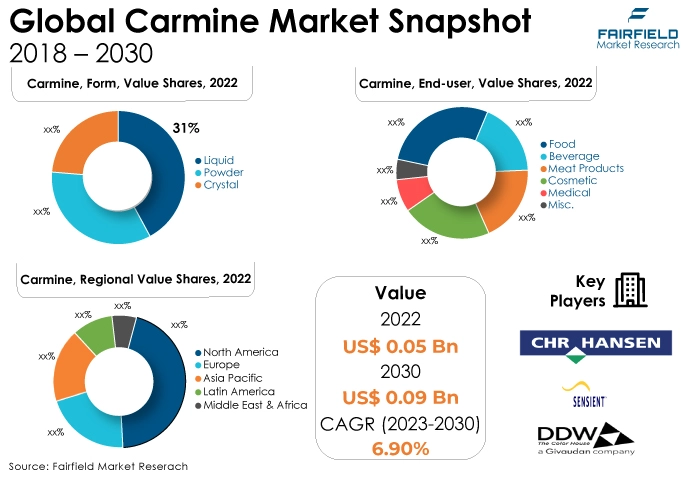
Major Report Findings - Fairfield's Perspective
- The carmine market is growing due to increasing consumer demand for natural & clean label ingredients in various industries, including food, cosmetics, and pharmaceuticals. Carmine, derived from cochineal insects, aligns with these preferences, driving its adoption and growth as a natural colourant.
- Dairy and frozen products are growing in the carmine market due to the vibrant red and pink hues carmine imparts, enhancing the visual appeal of ice creams, yogurts, and dairy-based desserts. Consumer demand for clean label and ingredients further drives the use of carmine in these products.
- Liquid form carmine is growing in the market due to its ease of use and versatility. It is readily soluble in water, making it suitable for various applications in the food, cosmetics, and pharmaceutical industries. Liquid carmine offers precise colour control and uniform distribution, contributing to its popularity and growth.
- Food processing is growing in the carmine market due to carmine's extensive use as a natural food colourant. It imparts appealing red and pink hues to various food products, aligning with consumer preferences for clean label ingredients. Stringent regulations on synthetic colourants also boost carmine adoption in food processing.
- Public-type schools, publicly funded but independently operated, dominate the Carmine market because they combine the advantages of private education with government support. They offer quality education without high tuition fees, making them popular among families seeking affordability and quality.
- North America is growing in the carmine market due to the region's increasing consumer demand for clean label and natural ingredients in food, cosmetics, and pharmaceuticals. Stringent regulatory support for carmine as a natural colourant further drives its adoption, fuelling growth in North America's carmine market.
- The Asia Pacific region is experiencing the fastest CAGR in the carmine market due to rising consumer awareness, demand for natural ingredients, and expanding food, cosmetic, and pharmaceutical industries. These factors are driving the adoption of carmine at an accelerated pace in the Asia Pacific region.
- High extraction costs pose a challenge in the carmine market as the labour-intensive process of collecting and processing cochineal insects can be costly. This cost factor can impact the overall production expenses and pricing of carmine-based products.
A Look Back and a Look Forward - Comparative Analysis
The carmine market is growing due to increasing consumer demand for natural and plant-based food colourants. Carmine, derived from cochineal insects, is a vivid and stable red pigment used in various food and beverage applications.
As consumers prioritise clean labels and seek alternatives to synthetic additives, Carmine's natural origin and vibrant colour make it a sought-after choice for food manufacturers, driving the market's expansion.
The market witnessed staggered growth during the historical period 2018 – 2022. This is due to the substantial growth of the major end-use application sectors, such as dairy & frozen products and cosmetics. The cosmetics application is growing in the carmine market because of its natural and vibrant red colour.
Carmine, derived from cochineal insects, is used as a natural pigment in cosmetics like lipsticks, blushes, and eyeshadows. As consumers increasingly seek clean and natural beauty products, Carmine's plant-based origin and intense colour make it an attractive option for cosmetic manufacturers, driving its growth in this sector.
The future of the carmine market appears promising as the demand for natural and plant-based food colourants continues to rise. Carmine, known for its vibrant red hue, aligns with consumers' preferences for clean labels and natural ingredients.
As the food industry increasingly seeks natural alternatives to synthetic dyes, Carmine is likely to see sustained growth and wider adoption in various food and beverage applications, ensuring a positive outlook for the market.
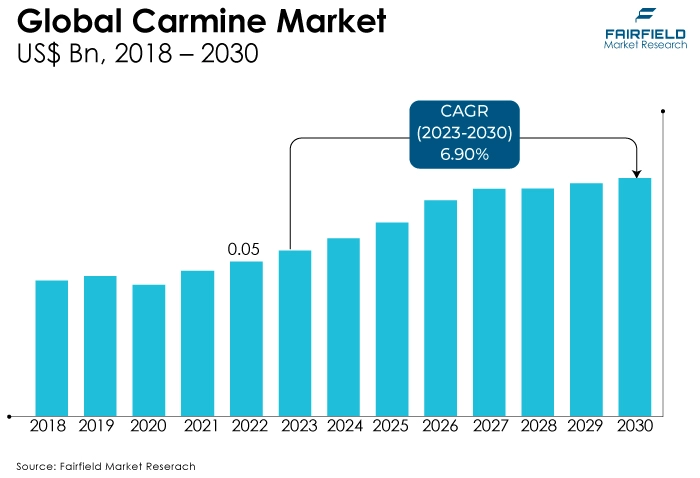
Key Growth Determinants
- Growing Need for Natural Food Ingredients and Colourants
The carmine market is experiencing growth due to the growing demand for food ingredients and colourants. As consumers become more health-conscious and seek products with clean labels, there is a growing preference for natural and plant-based alternatives to synthetic additives.
Carmine, derived from cochineal insects, is a natural and vibrant red colourant widely used in various food and beverage applications. Its plant-based origin and non-synthetic nature make it an attractive choice for manufacturers looking to meet consumer demands for clean and natural ingredients.
- Expansion of Cosmetic and Pharmaceutical Sector
The growth and expansion of the cosmetic and pharmaceutical sectors are propelling the carmine market. Carmine, a natural red pigment derived from cochineal insects, is valued for its vivid colour and safety profile. In cosmetics, it is used in products like lipsticks and blushes, while in pharmaceuticals, it serves as a colouring agent for oral medications.
The growing consumer preference for ingredients in both industries has boosted the demand for Carmine, driving its growth and adoption.
- Stringent Government Rules and Regulations
Stringent government rules and regulations are a driving force behind the carmine market. Regulatory bodies in the food, pharmaceutical, and cosmetic industries are increasingly emphasising the use of natural and safe ingredients.
Carmine, derived from cochineal insects, meets these criteria, and is recognised as a safe colouring agent. As regulations become more stringent, manufacturers are turning to Carmine as a compliant and natural alternative to synthetic colourants, driving its adoption and growth in various applications.
Major Growth Barriers
- High Extraction Costs of Natural Ingredients
The carmine market faces challenges due to the high extraction cost of natural ingredients. The process of extracting Carmine from cochineal insects is labour-intensive and requires significant resources, making it a costly endeavour. These high production costs can limit the affordability and competitiveness of Carmine compared to synthetic alternatives.
While Carmine is in demand for its natural properties, cost challenges may affect its widespread adoption in various applications, posing a hurdle to the market's growth.
- Lack of Awareness in Underdeveloped Nations
The carmine market encounters challenges stemming from a need for more awareness in undeveloped nations. In regions with limited access to information and education, consumers and manufacturers may need to be fully aware of the benefits and applications of Carmine as a natural food colourant.
The lack of awareness can hinder market penetration and adoption, restricting Carmine's usage in these regions and posing a challenge to its growth potential, especially in areas where synthetic colourants are more prevalent.
Key Trends and Opportunities to Look at
- Extraction and Processing Innovations
Extraction and processing innovations are revolutionising the carmine market. Enhanced techniques for harvesting cochineal insects and extracting carminic acid, the pigment in Carmine, are improving production efficiency and quality. These innovations result in higher yield and purity, making Carmine a more competitive and sustainable natural colourant.
Additionally, environmentally friendly farming practices are being employed, aligning with consumer demands for sustainable and eco-friendly ingredients.
- Quality Control and Testing
Quality control and testing technologies are playing a pivotal role in ensuring the purity and safety of carmine products. Advanced analytical methods, such as high-performance liquid chromatography (HPLC) and mass spectrometry, enable precise detection and quantification of carminic acid, the key pigment in Carmine.
This ensures compliance with quality standards and regulatory requirements, bolstering consumer confidence in the safety and authenticity of carmine-based products.
- Digital Marketing and E-commerce
Digital marketing and e-commerce technologies are transforming the carmine market by enabling companies to reach a broader audience and provide detailed product information. Through online platforms, manufacturers can showcase the natural and clean-label aspects of Carmine, appealing to health-conscious consumers.
Additionally, e-commerce facilitates convenient purchasing, making Carmine products more accessible to customers, ultimately driving market growth.
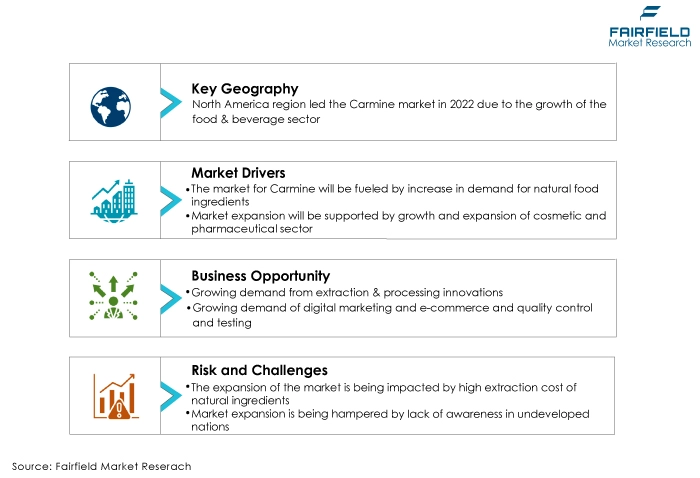
How Does the Regulatory Scenario Shape this Industry?
The regulatory landscape significantly shapes the carmine market. Regulatory bodies, such as the Food and Drug Administration (FDA) in the United States and the European Food Safety Authority (EFSA) in Europe, set strict guidelines regarding the use of food colourants, including Carmine. These regulations dictate permissible levels, labelling requirements, and safety standards for Carmine in various applications.
Carmine has faced scrutiny due to potential allergenic reactions and concerns about insect-based ingredients. In response, regulators have required comprehensive allergen labelling and established maximum residue limits to ensure consumer safety. Additionally, some regions have considered or implemented regulations requiring clear labelling of insect-derived ingredients, addressing transparency and allergen concerns.
The regulatory landscape is also evolving to align with consumer demands for clean labels and natural ingredients. As such, Carmine, as a natural colourant, benefits from this trend, as it aligns with the growing preference for pristine, transparent, and sustainable food products. Regulatory agencies continue to adapt to changing consumer preferences and emerging scientific evidence, shaping the carmine market by influencing its use, labelling requirements, and safety standards.
Fairfield’s Ranking Board
Top Segments
- Liquid Carmine Remains Preferred Form
The liquid form of Carmine has captured the largest market share due to its versatility and ease of use in various applications. Liquid Carmine is readily soluble in water, making it suitable for a wide range of products, including beverages, confectionery, and cosmetics. Its liquid form allows for precise colour control and uniform distribution, ensuring consistent and vibrant results.
Additionally, liquid Carmine is preferred in industrial processes, such as dyeing textiles and colouring pharmaceuticals, further contributing to its market dominance. Powder from carmine is likely to be experiencing the highest value CAGR due to several factors. Powdered Carmine offers advantages like longer shelf-life, easier storage, and reduced transportation costs compared to liquid forms.
It is highly versatile and can be used in applications ranging from bakery products to dry mixes and cosmetics. As consumers seek natural and clean-label ingredients, the powdered form aligns with these preferences, driving its adoption and growth in various industries and applications.
- Dairy & Frozen Application Category Surges Ahead
Dairy and frozen products have captured the largest market share in the carmine market due to their extensive use of Carmine as a natural colourant. Carmine is commonly employed to provide appealing red and pink hues to products like ice cream, yogurt, and dairy-based desserts.
Its stable and vivid colouration, along with consumer demand for natural and recognisable ingredients, has made Carmine a favoured choice in these categories. The natural origin of Carmine aligns with clean label trends, further solidifying its dominance in dairy and frozen products.
The cosmetics industry will experience the fastest CAGR in the carmine market due to the increasing demand for natural and clean-label ingredients in beauty products. Carmine, derived from cochineal insects, provides vibrant red and pink shades used in lipsticks, blushes, and eyeshadows.
As consumers prioritise natural and eco-friendly cosmetics, Carmine's natural origin and intense colour make it an attractive choice for manufacturers. This trend is driving the adoption and growth of Carmine in the cosmetics sector at an accelerated rate.
- Food Processing Sector Leads in Consumption
Food processing has captured the largest market share in the carmine market primarily due to Carmine's widespread use as a natural food colourant. Carmine imparts appealing red and pink hues to a variety of food products, including beverages, confectionery, bakery items, and sauces. Its versatility, stability, and natural origin align with consumer preferences for clean-label ingredients, making it an ideal choice for food processors.
Additionally, stringent regulations regarding synthetic colourants further boost the adoption of Carmine in the food processing industry, solidifying its dominant position.
The cosmetics and pharmaceutical sectors are experiencing the highest CAGR in the carmine market due to several factors. Carmine, a natural pigment derived from cochineal insects, is increasingly preferred in these sectors as consumers seek clean labels and natural ingredients.
In cosmetics, Carmine is used for vibrant shades in products like lipsticks and blushes. In pharmaceuticals, it serves as a safe colouring agent. The growth is driven by the convergence of consumer demand for natural products, regulatory approvals, and expanding product portfolios in these industries.
Regional Frontrunners
North America at the Forefront
North America has captured the largest market share in the carmine market due to several key factors. First, the region's strict regulatory environment, particularly in the United States, supports the use of Carmine as a safe and natural food and cosmetic colourant.
Consumer demand for clean-label products and natural ingredients has driven the adoption of Carmine in the food, cosmetics, and pharmaceutical industries. North American consumers prioritise products that are free from synthetic additives and allergens, aligning with Carmine's natural origin.
Additionally, the robust presence of major food and cosmetic manufacturers in North America contributes to the widespread use of Carmine, further solidifying the region's dominance in the global carmine market.
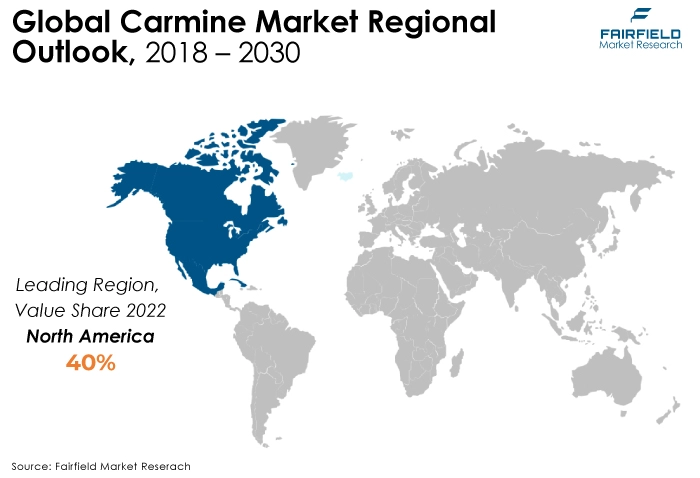
Asia Pacific to Demonstrate Strong Growth
Asia Pacific is experiencing the highest CAGR in the carmine market due to several factors. The region's expanding population and rising disposable income levels have led to increased consumer spending on food, cosmetics, and pharmaceuticals, where Carmine is widely used.
Furthermore, Asia Pacific's growing food processing industry and the trend towards natural and clean-label ingredients have driven the demand for Carmine. Regulatory approvals and a surge in product launches incorporating Carmine have further fuelled its growth in the region, making the Asia Pacific a key contributor to the Carmine market's expansion.
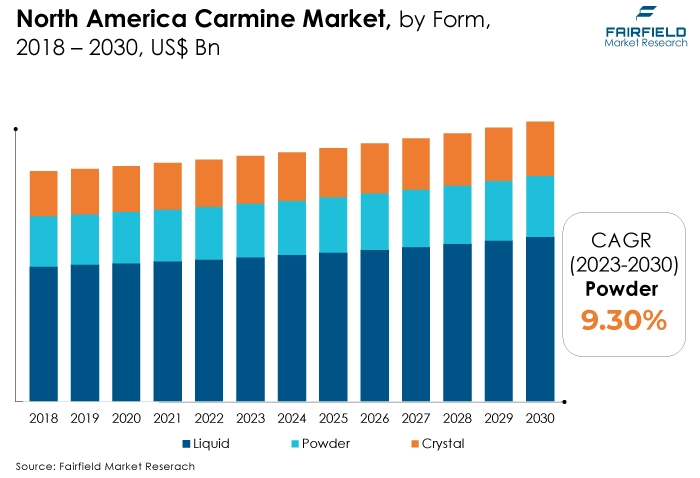
Fairfield’s Competitive Landscape Analysis
The key players engaged in Carmine manufacturing are introducing new products as well as working on distribution channels to enhance their worldwide presence. Moreover, Fairfield Market Research is expecting the market to witness more consolidation over the coming years.
Who are the Leaders in the Global Carmine Space?
- Chr.Hansen Holding A/S
- DDW The Colour House
- Sensient Technologies Corporation
- Amerilure, Inc.
- Döhler Group
- Proquimac
- Lake Foods
- Allied Biotech Corporation
- Biocon Colours
- KolorJet Chemicals Pvt. Ltd.
- Aarkay Food Products Ltd.
- Roha Dyechem Pvt. Ltd.
- Amba Gums & Feeds Products
- Pylote
- San-Ei Gen F.F.I., Inc.
Significant Company Developments
New Product Launches
- August 2022: Danone acquired the organic food producer Happy Family, which specialises in a range of organic products. Danone's management announced its agreement to receive 92% of Happy Family, a leading manufacturer of organic baby and infant food products.
- July 2022: Grain Forests launched a series of innovative organic products aimed at bridging the gap between rural farming and urban consumers. The new offerings include sprouted ragi for infants, a health mix tailored for people with diabetes, moringa powder designed for daily nutritional needs, and a ragi dosa mix ideal for a nourishing breakfast.
Distribution Agreement
- February 2021: Danone acquired Your Heart, a prominent player in the plant-based food industry. This acquisition aligns with the strategic goal of expanding Danone's business and meeting consumer demand by introducing a diverse range of organic products. It also positions Danone to maintain its leadership in the competitive plant-based food segment.
An Expert’s Eye
Demand and Future Growth
As per Fairfield’s Analysis, the carmine market is witnessing strong demand driven by the increasing consumer preference for natural and clean-label ingredients in various industries, including food, cosmetics, and pharmaceuticals.
As regulatory approvals and consumer awareness continue to grow, the future of the carmine market looks promising, with sustained growth expected as manufacturers seek natural alternatives to synthetic colourants.
Supply Side of the Market
The carmine market is influenced by several leading countries that play pivotal roles in its growth and prominence. The United States stands out as a significant player, driven by its stringent regulatory support for Carmine as a natural colourant. Carmine is extensively used in the US food, cosmetic, and pharmaceutical industries, where consumers value clean labels and natural ingredients.
Mexico, and Peru are also vital contributors to the carmine market due to their role as major producers of cochineal insects, which serve as a primary source of carmine pigment. These countries supply raw materials to manufacturers globally, sustaining the carmine industry's growth.
The primary raw material in the carmine market is cochineal insects, specifically the female Dactylopius coccus Costa species. These insects are cultivated on prickly pear cacti in regions like Mexico, and Peru. Cochineal insects are a valuable source of carminic acid, the pigment responsible for Carmine's vivid red and pink hues.
Mexico, and Peru are the major suppliers of cochineal insects, with Mexico historically being the largest producer. These countries provide a consistent and sustainable source of raw materials for carmine production, ensuring a stable supply chain for the global carmine market.
Global Carmine Market is Segmented as Below:
By Form:
- Powder
- Liquid
- Crystal
By Application:
- Meat Products
- Food
- Beverages
- Cosmetics
- Medical
- Miscellaneous
By Geographic Coverage:
- North America
- U.S.
- Canada
- Europe
- Germany
- U.K.
- France
- Italy
- Turkey
- Russia
- Rest of Europe
- Asia Pacific
- China
- Japan
- South Korea
- India
- Southeast Asia
- Rest of Asia Pacific
- Latin America
- Brazil
- Mexico
- Argentina
- Rest of Latin America
- Middle East & Africa
- GCC
- South Africa
- Egypt
- Nigeria
- Rest of the Middle East & Africa
1. Executive Summary
1.1. Global Carmine Market Snapshot
1.2. Future Projections
1.3. Key Market Trends
1.4. Regional Snapshot, by Value/Volume, 2022
1.5. Analyst Recommendations
2. Market Overview
2.1. Market Definitions and Segmentations
2.2. Market Dynamics
2.2.1. Drivers
2.2.2. Restraints
2.2.3. Market Opportunities
2.3. Value Chain Analysis
2.4. Porter’s Five Forces Analysis
2.5. COVID-19 Impact Analysis
2.5.1. Supply
2.5.2. Demand
2.6. Impact of Ukraine-Russia Conflict
2.7. Economic Overview
2.7.1. World Economic Projections
2.8. PESTLE Analysis
3. Global Carmine Market Outlook, 2018 - 2030
3.1. Global Carmine Market Outlook, by Form, Value (US$ Bn), 2018 - 2030
3.1.1. Key Highlights
3.1.1.1. Powder
3.1.1.2. Liquid
3.1.1.3. Crystal
3.2. Global Carmine Market Outlook, by Application, Value (US$ Bn), 2018 - 2030
3.2.1. Key Highlights
3.2.1.1. Meat Products
3.2.1.2. Food
3.2.1.3. Beverages
3.2.1.4. Cosmetics
3.2.1.5. Medical
3.2.1.6. Misc.
3.3. Global Carmine Market Outlook, by Region, Value (US$ Bn), 2018 - 2030
3.3.1. Key Highlights
3.3.1.1. North America
3.3.1.2. Europe
3.3.1.3. Asia Pacific
3.3.1.4. Latin America
3.3.1.5. Middle East & Africa
4. North America Carmine Market Outlook, 2018 - 2030
4.1. North America Carmine Market Outlook, by Form, Value (US$ Bn), 2018 - 2030
4.1.1. Key Highlights
4.1.1.1. Powder
4.1.1.2. Liquid
4.1.1.3. Crystal
4.2. North America Carmine Market Outlook, by Application, Value (US$ Bn), 2018 - 2030
4.2.1. Key Highlights
4.2.1.1. Meat Products
4.2.1.2. Food
4.2.1.3. Beverages
4.2.1.4. Cosmetics
4.2.1.5. Medical
4.2.1.6. Misc.
4.2.2. BPS Analysis/Market Attractiveness Analysis
4.3. North America Carmine Market Outlook, by Country, Value (US$ Bn), 2018 - 2030
4.3.1. Key Highlights
4.3.1.1. U.S. Carmine Market by Form, Value (US$ Bn), 2018 - 2030
4.3.1.2. U.S. Carmine Market Application, Value (US$ Bn), 2018 - 2030
4.3.1.3. Canada Carmine Market by Form, Value (US$ Bn), 2018 - 2030
4.3.1.4. Canada Carmine Market Application, Value (US$ Bn), 2018 - 2030
4.3.2. BPS Analysis/Market Attractiveness Analysis
5. Europe Carmine Market Outlook, 2018 - 2030
5.1. Europe Carmine Market Outlook, by Form, Value (US$ Bn), 2018 - 2030
5.1.1. Key Highlights
5.1.1.1. Powder
5.1.1.2. Liquid
5.1.1.3. Crystal
5.2. Europe Carmine Market Outlook, by Application, Value (US$ Bn), 2018 - 2030
5.2.1. Key Highlights
5.2.1.1. Meat Products
5.2.1.2. Food
5.2.1.3. Beverages
5.2.1.4. Cosmetics
5.2.1.5. Medical
5.2.1.6. Misc.
5.2.2. BPS Analysis/Market Attractiveness Analysis
5.3. Europe Carmine Market Outlook, by Country, Value (US$ Bn), 2018 - 2030
5.3.1. Key Highlights
5.3.1.1. Germany Carmine Market by Form, Value (US$ Bn), 2018 - 2030
5.3.1.2. Germany Carmine Market Application, Value (US$ Bn), 2018 - 2030
5.3.1.3. U.K. Carmine Market by Form, Value (US$ Bn), 2018 - 2030
5.3.1.4. U.K. Carmine Market Application, Value (US$ Bn), 2018 - 2030
5.3.1.5. France Carmine Market by Form, Value (US$ Bn), 2018 - 2030
5.3.1.6. France Carmine Market Application, Value (US$ Bn), 2018 - 2030
5.3.1.7. Italy Carmine Market by Form, Value (US$ Bn), 2018 - 2030
5.3.1.8. Italy Carmine Market Application, Value (US$ Bn), 2018 - 2030
5.3.1.9. Turkey Carmine Market by Form, Value (US$ Bn), 2018 - 2030
5.3.1.10. Turkey Carmine Market Application, Value (US$ Bn), 2018 - 2030
5.3.1.11. Russia Carmine Market by Form, Value (US$ Bn), 2018 - 2030
5.3.1.12. Russia Carmine Market Application, Value (US$ Bn), 2018 - 2030
5.3.1.13. Rest of Europe Carmine Market by Form, Value (US$ Bn), 2018 - 2030
5.3.1.14. Rest of Europe Carmine Market Application, Value (US$ Bn), 2018 - 2030
5.3.2. BPS Analysis/Market Attractiveness Analysis
6. Asia Pacific Carmine Market Outlook, 2018 - 2030
6.1. Asia Pacific Carmine Market Outlook, by Form, Value (US$ Bn), 2018 - 2030
6.1.1. Key Highlights
6.1.1.1. Powder
6.1.1.2. Liquid
6.1.1.3. Crystal
6.2. Asia Pacific Carmine Market Outlook, by Application, Value (US$ Bn), 2018 - 2030
6.2.1. Key Highlights
6.2.1.1. Meat Products
6.2.1.2. Food
6.2.1.3. Beverages
6.2.1.4. Cosmetics
6.2.1.5. Medical
6.2.1.6. Misc.
6.2.2. BPS Analysis/Market Attractiveness Analysis
6.3. Asia Pacific Carmine Market Outlook, by Country, Value (US$ Bn), 2018 - 2030
6.3.1. Key Highlights
6.3.1.1. China Carmine Market by Form, Value (US$ Bn), 2018 - 2030
6.3.1.2. China Carmine Market Application, Value (US$ Bn), 2018 - 2030
6.3.1.3. Japan Carmine Market by Form, Value (US$ Bn), 2018 - 2030
6.3.1.4. Japan Carmine Market Application, Value (US$ Bn), 2018 - 2030
6.3.1.5. South Korea Carmine Market by Form, Value (US$ Bn), 2018 - 2030
6.3.1.6. South Korea Carmine Market Application, Value (US$ Bn), 2018 - 2030
6.3.1.7. India Carmine Market by Form, Value (US$ Bn), 2018 - 2030
6.3.1.8. India Carmine Market Application, Value (US$ Bn), 2018 - 2030
6.3.1.9. Southeast Asia Carmine Market by Form, Value (US$ Bn), 2018 - 2030
6.3.1.10. Southeast Asia Carmine Market Application, Value (US$ Bn), 2018 - 2030
6.3.1.11. Rest of Asia Pacific Carmine Market by Form, Value (US$ Bn), 2018 - 2030
6.3.1.12. Rest of Asia Pacific Carmine Market Application, Value (US$ Bn), 2018 - 2030
6.3.2. BPS Analysis/Market Attractiveness Analysis
7. Latin America Carmine Market Outlook, 2018 - 2030
7.1. Latin America Carmine Market Outlook, by Form, Value (US$ Bn), 2018 - 2030
7.1.1. Key Highlights
7.1.1.1. Powder
7.1.1.2. Liquid
7.1.1.3. Crystal
7.2. Latin America Carmine Market Outlook, by Application, Value (US$ Bn), 2018 - 2030
7.2.1. Key Highlights
7.2.1.1. Meat Products
7.2.1.2. Food
7.2.1.3. Beverages
7.2.1.4. Cosmetics
7.2.1.5. Medical
7.2.1.6. Misc.
7.2.2. BPS Analysis/Market Attractiveness Analysis
7.3. Latin America Carmine Market Outlook, by Country, Value (US$ Bn), 2018 - 2030
7.3.1. Key Highlights
7.3.1.1. Brazil Carmine Market by Form, Value (US$ Bn), 2018 - 2030
7.3.1.2. Brazil Carmine Market Application, Value (US$ Bn), 2018 - 2030
7.3.1.3. Mexico Carmine Market by Form, Value (US$ Bn), 2018 - 2030
7.3.1.4. Mexico Carmine Market Application, Value (US$ Bn), 2018 - 2030
7.3.1.5. Argentina Carmine Market by Form, Value (US$ Bn), 2018 - 2030
7.3.1.6. Argentina Carmine Market Application, Value (US$ Bn), 2018 - 2030
7.3.1.7. Rest of Latin America Carmine Market by Form, Value (US$ Bn), 2018 - 2030
7.3.1.8. Rest of Latin America Carmine Market Application, Value (US$ Bn), 2018 - 2030
7.3.2. BPS Analysis/Market Attractiveness Analysis
8. Middle East & Africa Carmine Market Outlook, 2018 - 2030
8.1. Middle East & Africa Carmine Market Outlook, by Form, Value (US$ Bn), 2018 - 2030
8.1.1. Key Highlights
8.1.1.1. Powder
8.1.1.2. Liquid
8.1.1.3. Crystal
8.2. Middle East & Africa Carmine Market Outlook, by Application, Value (US$ Bn), 2018 - 2030
8.2.1. Key Highlights
8.2.1.1. Meat Products
8.2.1.2. Food
8.2.1.3. Beverages
8.2.1.4. Cosmetics
8.2.1.5. Medical
8.2.1.6. Misc.
8.2.2. BPS Analysis/Market Attractiveness Analysis
8.3. Middle East & Africa Carmine Market Outlook, by Country, Value (US$ Bn), 2018 - 2030
8.3.1. Key Highlights
8.3.1.1. GCC Carmine Market by Form, Value (US$ Bn), 2018 - 2030
8.3.1.2. GCC Carmine Market Application, Value (US$ Bn), 2018 - 2030
8.3.1.3. South Africa Carmine Market by Form, Value (US$ Bn), 2018 - 2030
8.3.1.4. South Africa Carmine Market Application, Value (US$ Bn), 2018 - 2030
8.3.1.5. Egypt Carmine Market by Form, Value (US$ Bn), 2018 - 2030
8.3.1.6. Egypt Carmine Market Application, Value (US$ Bn), 2018 - 2030
8.3.1.7. Nigeria Carmine Market by Form, Value (US$ Bn), 2018 - 2030
8.3.1.8. Nigeria Carmine Market Application, Value (US$ Bn), 2018 - 2030
8.3.1.9. Rest of Middle East & Africa Carmine Market by Form, Value (US$ Bn), 2018 - 2030
8.3.1.10. Rest of Middle East & Africa Carmine Market Application, Value (US$ Bn), 2018 - 2030
8.3.2. BPS Analysis/Market Attractiveness Analysis
9. Competitive Landscape
9.1. Manufacturer vs Application Heatmap
9.2. Company Market Share Analysis, 2022
9.3. Competitive Dashboard
9.4. Company Profiles
9.4.1. Chr. Hansen Holding A/S
9.4.1.1. Company Overview
9.4.1.2. Product Portfolio
9.4.1.3. Financial Overview
9.4.1.4. Business Strategies and Development
9.4.2. DDW The Colour House
9.4.2.1. Company Overview
9.4.2.2. Product Portfolio
9.4.2.3. Financial Overview
9.4.2.4. Business Strategies and Development
9.4.3. Sensient Technologies Corporation
9.4.3.1. Company Overview
9.4.3.2. Product Portfolio
9.4.3.3. Financial Overview
9.4.3.4. Business Strategies and Development
9.4.4. Döhler Group
9.4.4.1. Company Overview
9.4.4.2. Product Portfolio
9.4.4.3. Financial Overview
9.4.4.4. Business Strategies and Development
9.4.5. Proquimac
9.4.5.1. Company Overview
9.4.5.2. Product Portfolio
9.4.5.3. Financial Overview
9.4.5.4. Business Strategies and Development
9.4.6. Lake Foods
9.4.6.1. Company Overview
9.4.6.2. Product Portfolio
9.4.6.3. Financial Overview
9.4.6.4. Business Strategies and Development
9.4.7. Allied Biotech Corporation
9.4.7.1. Company Overview
9.4.7.2. Product Portfolio
9.4.7.3. Financial Overview
9.4.7.4. Business Strategies and Development
9.4.8. Biocon Colors
9.4.8.1. Company Overview
9.4.8.2. Product Portfolio
9.4.8.3. Financial Overview
9.4.8.4. Business Strategies and Development
9.4.9. KolorJet Chemicals Pvt. Ltd.
9.4.9.1. Company Overview
9.4.9.2. Product Portfolio
9.4.9.3. Financial Overview
9.4.9.4. Business Strategies and Development
9.4.10. Aarkay Food Products Ltd.
9.4.10.1. Company Overview
9.4.10.2. Product Portfolio
9.4.10.3. Financial Overview
9.4.10.4. Business Strategies and Development
9.4.11. Roha Dyechem Pvt. Ltd.
9.4.11.1. Company Overview
9.4.11.2. Product Portfolio
9.4.11.3. Financial Overview
9.4.11.4. Business Strategies and Development
9.4.12. Amba Gums & Feeds Products
9.4.12.1. Company Overview
9.4.12.2. Product Portfolio
9.4.12.3. Financial Overview
9.4.12.4. Business Strategies and Development
9.4.13. San-Ei Gen F.F.I., Inc.
9.4.13.1. Company Overview
9.4.13.2. Product Portfolio
9.4.13.3. Financial Overview
9.4.13.4. Business Strategies and Development
9.4.14. Pylote
9.4.14.1. Company Overview
9.4.14.2. Product Portfolio
9.4.14.3. Financial Overview
9.4.14.4. Business Strategies and Development
9.4.15. Amerilure, Inc.
9.4.15.1. Company Overview
9.4.15.2. Product Portfolio
9.4.15.3. Financial Overview
9.4.15.4. Business Strategies and Development
10. Appendix
10.1. Research Methodology
10.2. Report Assumptions
10.3. Acronyms and Abbreviations
|
BASE YEAR |
HISTORICAL DATA |
FORECAST PERIOD |
UNITS |
|||
|
2022 |
|
2018 - 2022 |
2023 - 2030 |
Value: US$ Million |
||
|
REPORT FEATURES |
DETAILS |
|
Form Coverage |
|
|
Application Coverage |
|
|
Geographical Coverage |
|
|
Leading Companies |
|
|
Report Highlights |
Key Market Indicators, Macro-micro economic impact analysis, Technological Roadmap, Key Trends, Driver, Restraints, and Future Opportunities & Revenue Pockets, Porter’s 5 Forces Analysis, Historical Trend (2019-2021), Market Estimates and Forecast, Market Dynamics, Industry Trends, Competition Landscape, Category, Region, Country-wise Trends & Analysis, COVID-19 Impact Analysis (Demand and Supply Chain) |
